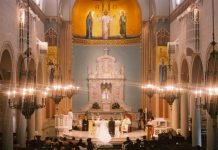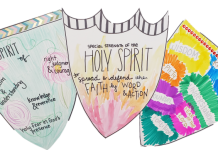
by Jeanne Heiberg
Some of the most important things in our lives are things that we cannot see. Using poetry can help us grasp the invisible treasures of the Sacraments.
Poetry often expresses in words things we cannot see—important things like love, happiness, care, and friendship. Poetic expressions can associate these important things with words like flowers, teacup, and ocean so that we can better understand them and visualize them. For example, think of a “teacup” of friendship or an “ocean” of happiness. Such poetic terms present the invisible and the abstract in a new light.
A book I read helped me to write and teach poetry. It said to make a list of at least five invisible things to put in a teacup—such as a teacup full of nostalgia or wisdom. The invisible thing could be something unpleasant or difficult, too, such as a teacup full of suspicion or anger. Although I like the happier feelings more, it’s important to express different feelings at different times, and poetry helps us do that.
Our Senses and the Sacraments
Poetry helps us appreciate the Sacraments that give us the wonderful, fantastic, invisible gift of God’s grace—the very life and joy of God. Jesus came to bring us into the life of God, which we can’t know through our senses—taste, touch, sight, sound, smell. But because we are physical beings with bodies, we need visible, tangible things to help us grasp the gift of God’s grace, to remind us that God is truly present to us. Concrete things help us know Jesus is still with us. In the Sacraments, we can taste, touch, see, hear, and smell things that make tangible the presence of Jesus.
Just as poetry uses words that are signs and symbols with which our senses can relate and understand, Jesus uses down-to-earth, concrete, and familiar things—like bread and wine, water, oil, and touch—to bring to us the reality of his presence. In the Sacraments that Jesus gave us, we experience God’s love, friendship, healing, forgiveness, blessing, anointing, and saving grace. The very tangible signs and symbols of the Sacraments make it possible for us to better understand and experience the wonder of God.
The following procedure can help your learners use their imaginations and poetic expressions to understand better the invisible power of the Sacraments.
Say to the Children
In our religion classes, we learn about Sacraments, seven gifts Jesus gives that bring grace. Grace is God’s life, God’s presence, in us. We cannot see the treasures of the Sacraments, so Jesus uses visible, concrete signs and symbols. The Church uses these concrete signs and symbols in beautiful liturgies with deep meanings. Over time—many years—we grow in faith and so better understand the grace of the Sacraments.
Let’s think about the symbols that come to mind with each Sacrament.
Water is a symbol of Baptism. Water is pure and refreshing and gives life to all living things. It is cleansing. Other symbols of Baptism might be the baptismal font, candles, the precious oils, or a white garment.
Bread and wine are symbols of Eucharist. Bread and wine as nourishment for our bodies become the Body and Blood of Jesus, the Bread of Life. Other symbols of Eucharist might be wheat and grapes or an altar.
The Sign of the Cross is a symbol of Penance and Reconciliation. The priest makes the Sign of the Cross as he blesses us with absolution at the end of our confession. Other symbols of Penance and Reconciliation might be crossed keys, representing the power Jesus gave Peter and the Apostles to forgive sins.
A small flame (tongue of fire) is a symbol of Confirmation. In Scripture, the Holy Spirit descends on the Apostles in the form of “tongues as of fire” (Acts 2:1-13). Other symbols of Confirmation might be a dove, the wind, or a bishop’s hand on a confirmandi’s shoulder.
The forehead being anointed with oil is a symbol of the Anointing of the Sick.The Oil of the Sick is used to anoint the person who is ill, to bless the person with the strength of God’s healing grace. Another symbol for the Anointing of the Sick might be an olive branch.
Two interlocking rings symbolize the Sacrament of Matrimony. Sometimes the rings are positioned on a cross because Jesus is central to the covenant the man and woman enter. Interlocking rings symbolize two individuals becoming one in the sight of God through Jesus Christ. Another symbol for Matrimony might be a knotted cord.
A stole is a symbol of Holy Orders. The priest wears a stole during the celebration of the Sacraments, representing his ordained role and the presence of Christ in him. Another symbol for Holy Orders might be the chalice and paten.
Jesus wants to be present to us, so he gave us the Sacraments. When we connect the Sacraments with their symbols, we can better understand his love for us in the invisible treasures that the Sacraments are for us throughout our lives. God’s grace is with us in every big job in life and in every little job too.
Now that we understand the symbols for the Sacraments, what can we do to help us remember what we learned? We can use poetry with these symbols of the Sacraments to help us better remember God’s grace and what we celebrate in each Sacrament. Now unlike mathematics, for example, in which there are exact measurements and answers, poetry and art involve nothing exact, nothing that is right or wrong. Rather, we simply express our thoughts and feelings—which are very important.
We are all made in the image of God, and so we are creative in all kinds of wonderful ways. One way we can be creative is with words, like those who were inspired by God in writing Scripture. We can write prayers and poems about the Sacraments and the symbols of the Sacraments. We can make booklets on the Sacraments and their symbols, and we can write poetry to go with each one.
Have students make booklets that will help them remember the meaning of the symbols of the Sacraments and give them a way to express their understanding of the Sacraments and joy in God’s grace.
ACTIVITY: Sacrament Book Craft
MATERIAL
* 2 sheets of 8 ½” x 11” white copy paper for each booklet (for interior pages)
* additional paper for practice writing
* 1 sheet of 9” x 12” construction paper for each booklet (for cover, any color)
* hole punch
* hemp (or any cord or ribbon) for binding
* fine markers and colored pencils
* ruler (as needed)
* magazines
* scissors
* glue sticks
* sticker letters, if preferred
PROCEDURE
1. After sharing with students the information in “Say to the Children,” allow a few prayerful moments for them to talk to God in the quiet of their hearts and in their own words. Tell them to share with God what they feel about life and how wonderful the Sacraments are, to ask God questions, to thank God, to tell God their dreams and fears.
2. Share some of the images presented here with students so they can use these ideas or develop their own for a booklet about the Sacraments and their symbols. Encourage them to imagine putting things they cannot see into things they can see, such as “a loaf of love” or a “chalice (or cup) of inspiration” or an “ocean of devotion.”
3. Have students write one poem—free verse or rhyming—about each Sacrament (perhaps using the Sacrament’s symbol), expressing the grace and gifts of the Sacrament in some way.
4. Have students find images in magazines or draw images that support each poem. Then have them assemble booklets following steps 5-7.
5. Place 2 pieces of 8 ½” x 11” copy paper on top of each other and fold in half, width-wise, so that you have an 8-page booklet measuring 5 ½” wide and 8 ½” deep.
6. Come up with a name for your booklet and write that on the “first page” of the booklet. Then on each subsequent page, write the poem for a Sacrament and draw or glue an image to go with the poem. Illustrate your poems with color swatches from magazines, borders, or other symbols of faith.
7. Fold a sheet of construction paper around the outside of the booklet to serve as a cover. Put the same title of the book on the cover that you put on the first inside page. Punch two holes along the side of the booklet and thread hemp, cord, or ribbon through the holes to bind the booklet together.
Sacraments and Poetry Prayer
The Bible, especially the Psalms, includes poems and prayers. Encourage your students to write their own prayers and poems from time to time and use them as classroom prayer. Use theirs in the following prayer; let each child share something to thank or praise God for the Sacraments in their own words.
Opening Song: “I’ve Got the Joy (joy, joy, joy down) in My Heart”
Opening Prayer: Loving Lord, you are Creator of everything. Through your Son, Jesus, you have given us the Sacraments which bring us your saving and healing grace. You have made us in your image to be creative in partnership with you. With the grace of the Sacraments, teach us to form what is good, true, and beautiful with our words, both spoken and written, and with our actions. May the works of our hands, minds, and hearts give you praise and glory, and draw people to your liturgy, love, and worship. We ask this in Jesus’ name.
All: Amen.
Reading: Acts 2 (the coming of the Holy Spirit)
Student Prayers/Poems: Invite students to share the prayers and poems they wrote about the Sacraments.
Closing Prayer: Loving God, you sent Jesus, your Son and our loving brother, to teach us about your love and to draw us into unity with you through the Holy Spirit. He gave us the Sacraments to draw us into your great family and to lead us further on our path to you. Help us to continue Jesus’ mission in the world, to welcome others, to build up your Church, to express your invisible presence in the way we visibly live our lives.
All: Amen.
Jeanne Heiberg is the author of Advent Arts and Christmas Crafts (Paulist Press) and Advent calendars (Creative Communications). She has taught art, writing, creative catechetics, and meditation, and has directed parish catechetical programs.
Copyright 2012, Bayard, Inc. All rights reserved. This article is protected by United States copyright and other intellectual property laws and may not be reproduced, rewritten, distributed, redisseminated, transmitted, displayed, published or broadcast, directly or indirectly, in any medium without the prior written permission of Bayard, Inc.
This article was written by the Catechist Staff and appeared in Catechist magazine, December 2011.
Image Credit: Shutter Stock 383838703




